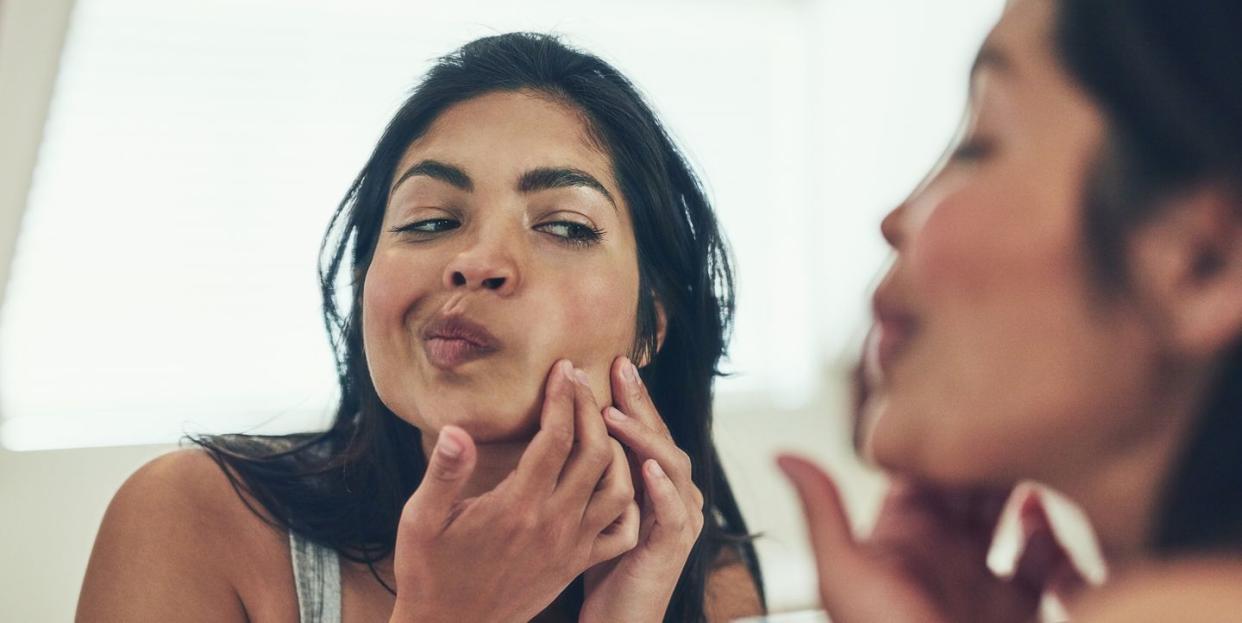The Best Ways to Get Rid of Whiteheads

"Hearst Magazines and Yahoo may earn commission or revenue on some items through the links below."
Whiteheads. Acne. Chicken skin. Whatever you call those white bumps on your face, arms, and body, they can be extremely frustrating. Even if you’re using doctor-recommended anti-aging creams with retinol or are diligent about your self-care routine, including a weekly detoxifying clay mask, whiteheads can prove tricky to treat. Luckily, though, it is possible to get rid of those pesky acne bumps—both at home, or by visiting your dermatologist. Here, a complete guide to banishing whiteheads, once and for all.
First things first: what are whiteheads?
“A whitehead is a pore—which is the skin surface opening of a hair follicle—that becomes completely clogged with dead skin cells, sebum (oil) and bacteria and remains closed at the surface,” explains Keira L. Barr, double-board-certified MD, founder, and chief wellness officer of Resilient Health Institute.
Diet and lifestyle can definitely play in causing them. “The most notorious culprits contributing to breakouts include dairy, sugar, and processed foods with an abundance of additives and preservatives,” says Barr, adding, “Dairy and sugar in particular stimulate IGF-1 (insulin growth factor-1) which triggers your oil glands to produce more oil and stimulates inflammation which contributes to acne. Adjusting your diet to include low-glycemic carbohydrates, healthy fats, protein, and antioxidant rich foods can help.” Barr also cautions that stress and lack of sleep can cause hormone imbalances and fluctuations, potentially worsening breakouts.
Is it okay to pop the whitehead?
Yes, but proceed with caution. "You only want to pop a pimple or whitehead that is very superficial. Don’t manipulate a spot that's red, inflamed, or deep under the skin—like a cyst or nodule—as you'll significantly increase the risk of pain, infection, scarring, and inflammation," says Barr.
And if you do pop, here's how to do it safely:
"Cleanse the affected area with a gentle exfoliator like salicylic acid and/or anti-bacterial agent like benzoyl peroxide, then apply a warm compress.
Use Q-tips to pop your whitehead.
Then, wrap clean tissue paper around your fingers or a Q-tip in each hand. It’s helpful to first stretch the skin away from the pimple and then apply pressure in the direction of the pimple using a gentle but firm touch. Applying traction in the direction away from the pimple may cause it to 'pop' on its own." And if it's not popping easily, don't force it—otherwise, you could make things worse. When finished, cleanse the area again.
The Best Products to Get Rid of Whiteheads
“There are numerous remedies you can try at home to get rid of whiteheads, including over the counter products with ingredients such as benzoyl peroxide, salicylic acid and retinoids—all can be helpful,” says Barr. Try Kiehl’s Breakout Control Facial Lotion ($50) or Neutrogena Rapid Clear Stubborn Acne Spot Gel ($9) with antimicrobial and anti-inflammatory benzoyl, Paula’s Choice 2% BHA Liquid Exfoliant ($34) or Kate Somerville EradiKate Salicylic Acid Acne Treatment ($68) with dead-skin-sloughing salicylic, The Ordinary Granactive Retinoid 2% Emulsion ($10) or Drunk Elephant A-Passioni Retinol Cream ($74) with retinoids, or even prescription Differin 1% gel, which helps cell turnover and opens pores.
Is there a fast way to get rid of whiteheads at home?
"Using a spot treatment with products like Acnomel, sulfur 8 percent, or Mario Badescu Drying Lotion, can speed up the process," says Barr. Other options? Try applying ice—it’ll help with redness and inflammation—and alternate with warm compresses to help with drainage. Barr also recommends making a paste out of crushed aspirin, as well as over the counter hydrocortisone 1% cream to help reduce redness and inflammation.
A DIY paste of crushed aspirin and hydrocortisone cream will reduce redness.
What's the best way to get rid of whiteheads around nose?
Your T-zone—which includes the forehead, nose, and chin—have a greater concentration of oil glands, leading to a higher likelihood of breakouts, clogged pores and inflammation. “When whiteheads appear, it’s best to treat the entire acne-prone area rather than chasing individual pimples,” explains Dr. Barr, adding, “the same ingredients that can be used to treat whiteheads can also be used to prevent them including, alpha hydroxy acids (like glycolic or lactic), beta hydroxy acids (like salicylic acid) and topical retinoids. These ingredients all are helpful for unclogging the pores.”
Antimicrobial tea tree oil and benzoyl peroxide might also help kill acne-contributing bacteria, as can witch hazel.
What's the best way to get rid of whiteheads on cheeks?
“If you’re breaking out specifically on your cheeks and especially if one side is worse than the other, think about your daily habits. Research has shown our cell phones are dirtier than toilets seats, with 75 percent of Americans using their cell phones while in the bathroom. That means that anytime you hold your phone to your face, you’re spreading that bacteria to your skin, which could cause more acne. Persistent acne limited to one side of your face tends to be due to dirty phones, pillowcases, or other habits like touching your face," Barr.
A potential solution? Barr recommends avoiding bringing your phone into the restroom, wiping your smartphone down before use, swapping out your pillowcase weekly, and being more mindful of how much you are touching your face.
Your dermatologist can help you treat them, too.
“Acne is the most common skin condition in the United States affecting 50 million Americans annually, including more than 85% of adolescents and 25% of adults worldwide,” says Barr. “Acne can have a significant impact on emotional well-being including anxiety, depression, and social isolation. If whiteheads are taking a toll on your self-esteem, then absolutely, make an appointment with your dermatologist so you don’t have to suffer unnecessarily."

What's the best way to get rid of whiteheads on arms?
“Although acne can occur on the arms, one of the more common conditions that affects hair follicles on the arms is called keratosis pilaris, which is caused by the build-up of keratin in the hair follicle,” says Dr. Barr adding, “Some people refer to keratosis pilaris (KP) as chicken skin, since it can resemble goosebumps and feel like sandpaper.
Hydration and gentle exfoliation help with what appears to be whiteheads on the arms.
Although there is no known cure, this condition may resolve on its own. "KP doesn’t just happen on arms: cheeks, legs, and buttocks can fall victim, too. “Hydrating the skin and gentle exfoliation are the best ways to manage the condition. Using products that can aid in removing the excess keratin including lactic acid, urea, glycolic acid, azelaic acid, and willow bark (which is a source of salicylic acid) are helpful.” Dr. Barr also recommends extremely gentle exfoliation with a loofah. “The key is to be very gentle to minimize irritation, as there can be redness and mild itch or irritation associated with the condition, and you don’t want to make that worse by being too aggressive.”
What about whiteheads on eyelids?
Actually, if you have tiny white bumps on your eyelids, they’re likely not whiteheads at all, but instead lesions called milia, which is caused by trapped dead skin cells, according to the Cleveland Clinic. “These are small epidermoid cysts and are quite common, occuring at all ages of life,” says Dr. Barr. “These can resolve spontaneously. If treatment is desired they can be extracted by your dermatologist or esthetician. If they are on the face (other than the eyelids) using a topical retinoid can help facilitate resolution.”
You Might Also Like

